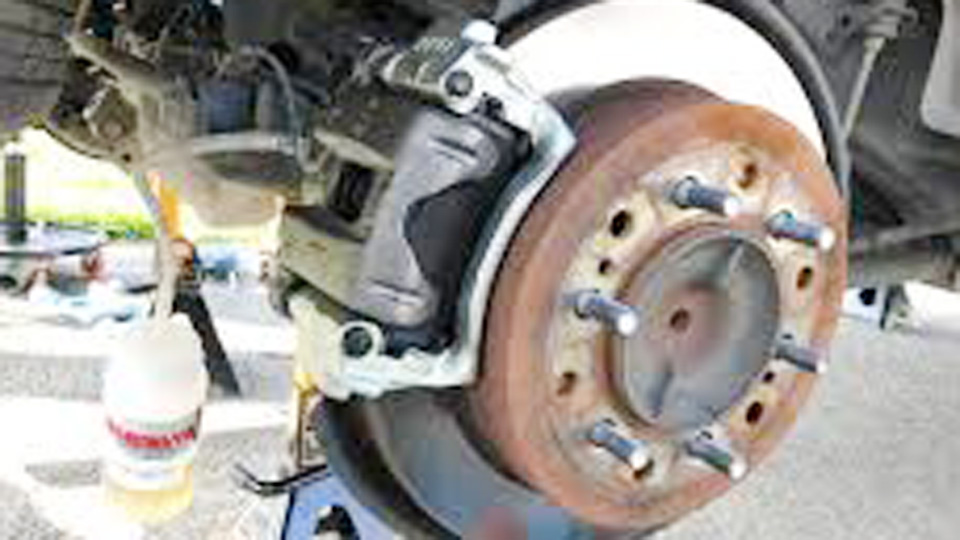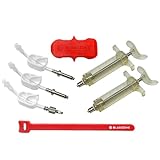Can You Bleed Brakes Without Removing Wheels?
I’ve been tinkering with cars for years, and this question comes up a lot, especially among DIY folks like me who want to save time and effort. Bleeding brakes is a crucial maintenance task to keep your car stopping smoothly, and the idea of skipping the wheel removal step sounds like a game-changer. Spoiler alert: it’s totally possible in many cases!

Photo by thetrackahead
As someone who’s bled brakes on everything from sedans to trucks, I’m excited to share what I’ve learned. Let’s dive into whether you can bleed brakes without removing the wheels, how to do it, and what you need to know to get it right.
What Does Bleeding Brakes Mean?
| # | Preview | Product | |
|---|---|---|---|
| 1 |

|
BleedZone Brake Bleed Kit for SRAM Brakes Series Bleeding Edge Tools - SRAM Hydraulic Bike Brake... | Check Price on Amazon |
Before we get into the nitty-gritty, let’s talk about what bleeding brakes actually means. Your car’s brake system uses hydraulic fluid to transfer the force from your brake pedal to the brake pads. Over time, air bubbles can sneak into the brake lines, making your pedal feel spongy or reducing stopping power.
Bleeding brakes is the process of removing those air bubbles to restore a firm brake pedal. I remember the first time I felt a mushy pedal—it was like stepping on a marshmallow! Bleeding the brakes fixed it right up.
The question is, do you need to remove the wheels to do this? In many cases, the answer is no, but it depends on your car and how you approach it. Let’s break it down.
Why You Might Want to Bleed Brakes Without Removing Wheels
Removing wheels can be a hassle. You need a jack, jack stands, a lug wrench, and some elbow grease. Plus, it adds time to the job. I’ve been in situations where I just wanted to bleed the brakes quickly without wrestling with lug nuts.
Keeping the wheels on saves effort, especially if you’re working in a tight space or don’t have all the tools handy. It’s also great for quick maintenance checks or when you’re on the road. But there are some things to consider, so let’s explore when and how you can skip wheel removal.
When Can You Bleed Brakes Without Removing Wheels?
The ability to bleed brakes without removing wheels depends on your car’s design. Most vehicles have bleed valves (or bleeder screws) on the brake calipers or wheel cylinders, located behind the wheels. If you can access these valves without removing the wheel, you’re in luck. Here’s what I’ve found from working on various cars.
Vehicles with Accessible Bleed Valves
Many cars, especially compact sedans and some SUVs, have enough clearance to reach the bleed valve with the wheel in place. For example, I’ve bled brakes on my old Honda Civic without touching the wheels.
The bleeder screw was easy to reach with a wrench by turning the steering wheel to angle the tire. Front-wheel-drive cars often have more accessible front calipers, making this method doable.
Vehicles with Tight Spaces
Some vehicles, like trucks or high-performance cars with big brakes, have tighter spaces. I once tried bleeding the brakes on a Dodge Ram, and the wheel well was so cramped that I couldn’t get a wrench in without removing the wheel. In these cases, taking the wheel off might be faster than struggling to reach the valve.
Disc Brakes vs. Drum Brakes
Disc brakes, found on most modern cars’ front wheels (and often the rear), usually have bleeder screws on the caliper. These are often easier to access than drum brakes, which are common on older cars or rear axles of some trucks.
Drum brakes have wheel cylinders with bleeder screws that are sometimes hidden behind the drum, making wheel removal more likely. I’ve worked on drum brakes where I had to pull the wheel and drum to get to the bleeder—definitely not my favorite job!
Tools You’ll Need to Bleed Brakes
Whether you’re keeping the wheels on or not, you’ll need the right tools. Here’s what I always have on hand when bleeding brakes:
- Wrench: A box-end or flare-nut wrench (usually 8mm or 10mm) to open the bleeder screw.
- Brake Fluid: Check your car’s manual for the right type (usually DOT 3 or DOT 4).
- Clear Tubing: To catch the fluid and watch for air bubbles.
- Catch Bottle: A small container to collect old fluid.
- Jack and Jack Stands (optional): If you need to lift the car for better access.
- Helper (optional): Someone to pump the brake pedal while you open the bleeder screw.
I always keep a rag handy to wipe up spills—brake fluid can damage paint, and I learned that lesson the hard way on my first project car!
How to Bleed Brakes Without Removing Wheels
Now, let’s get to the good stuff: how to actually bleed your brakes without taking the wheels off. I’ll walk you through the steps I use, based on years of doing this in my driveway.
Step 1: Prepare Your Car
Park your car on a flat surface and engage the parking brake. Pop the hood and locate the brake fluid reservoir. Check the fluid level and top it off with the correct brake fluid. I always make sure the reservoir cap is loose so fluid can flow during bleeding.
Step 2: Locate the Bleeder Screws
Find the bleeder screws on each wheel’s brake caliper or wheel cylinder. They look like small bolts with a nipple for attaching tubing. For front wheels, try turning the steering wheel to one side to improve access. I’ve found that full lock (steering all the way left or right) often gives enough room to reach the screw.
Step 3: Set Up Your Tools
Attach a piece of clear tubing to the bleeder screw’s nipple. Place the other end in a catch bottle with a little brake fluid inside to prevent air from being sucked back in. I like to use a small plastic bottle with a tight lid to keep things clean.
Step 4: Bleed the Brakes
Start with the wheel furthest from the master cylinder—usually the rear passenger side. Have a helper pump the brake pedal a few times, then hold it down. Open the bleeder screw a quarter turn with your wrench.
Fluid and air bubbles will flow through the tubing. Close the screw before your helper releases the pedal. Repeat until no air bubbles come out. I usually do this 3–5 times per wheel, checking the reservoir to make sure it doesn’t run dry.
Step 5: Move to the Next Wheel
Work your way to the next furthest wheel (rear driver’s side, then front passenger, then front driver’s side). Repeat the bleeding process for each. If you’re working alone, a one-man bleeder kit with a check valve can make this easier—I’ve used one on my truck and it’s a lifesaver.
Step 6: Check and Test
Once all wheels are bled, top off the brake fluid reservoir and tighten the cap. Test the brake pedal—it should feel firm. Take your car for a slow test drive to make sure the brakes work properly. I always start with a gentle stop in my driveway to be safe.
Challenges of Bleeding Brakes Without Removing Wheels
While it’s possible to bleed brakes without removing wheels, it’s not always a walk in the park. Here are some challenges I’ve run into.
Limited Access
Some cars have tight wheel wells or large brake components that make it hard to reach the bleeder screw. I once worked on a Jeep where the caliper was so close to the wheel that I could barely fit my wrench. In these cases, removing the wheel might actually save time.
Risk of Stripping the Bleeder Screw
Bleeder screws can be stubborn, especially if they’re rusted. If you can’t get a good angle with your wrench, you risk stripping the screw. I’ve had to use penetrating oil and a lot of patience to avoid this.
Messy Fluid Spills
Brake fluid is messy and can drip onto your wheel or tire if you’re not careful. I always keep a rag and some soapy water nearby to clean up spills immediately.
When Should You Remove the Wheels?
Sometimes, removing the wheels is the better option. Here’s when I decide to grab my lug wrench:
- Tight Spaces: If you can’t reach the bleeder screw comfortably, taking the wheel off gives you better access.
- Drum Brakes: Many drum brake systems require wheel and drum removal to reach the bleeder screw.
- Inspection Needs: If you suspect other brake issues (like worn pads), removing the wheel lets you inspect everything.
Removing a wheel takes about 10 minutes per side with a jack and lug wrench. It’s not a huge deal, but I get why you’d want to avoid it.
Tips for Successful Brake Bleeding
Here are some tricks I’ve picked up to make brake bleeding easier:
- Work Clean: Brake fluid is corrosive, so wipe up spills right away.
- Use the Right Fluid: Always check your car’s manual for the correct brake fluid type.
- Don’t Let the Reservoir Run Dry: This can introduce more air into the system, undoing your work.
- Be Patient: Bleeding brakes takes time. Rushing can lead to mistakes.
- Check for Leaks: After bleeding, inspect the bleeder screws and lines for leaks.
Cost of Bleeding Brake
Bleeding brakes is a relatively affordable job. Here’s a quick cost breakdown based on my experience in the USA:
| Service | Estimated Cost |
|---|---|
| DIY Brake Bleeding | $10–$30 (fluid and tools) |
| Professional Brake Bleeding | $100–$200 per axle |
Doing it yourself is way cheaper, and keeping the wheels on saves even more time. I’ve saved hundreds over the years by learning to do this at home.
Preventing Air in Your Brake System
To avoid needing to bleed your brakes too often, here’s what I do:
- Check Fluid Regularly: Top off the reservoir during routine maintenance.
- Inspect for Leaks: Look for wet spots around brake lines or calipers.
- Drive Smoothly: Hard braking can stress the system and introduce air.
- Replace Fluid Periodically: Old fluid can absorb moisture, leading to air bubbles. I flush my system every 2 years.
When to Call a Professional
If you can’t get a firm pedal after bleeding or you’re dealing with a stripped bleeder screw, it’s time for a pro. I’ve taken my car to a shop when I suspected a bad master cylinder—those are tricky to diagnose and fix. A professional brake service might cost $100–$300, depending on the issue and your location.
Conclusion
Bleeding your car’s brakes without removing the wheels is not only possible but also a huge time-saver for many vehicles. I’ve done it countless times on my own cars, and there’s something satisfying about feeling that firm brake pedal after a job well done. By understanding your car’s brake system, using the right tools, and following a careful process, you can tackle this task like a pro.
There might be challenges like tight spaces or stubborn screws, but with patience, you can get it done. If things get tricky, don’t hesitate to call a mechanic—your safety comes first. Now that you know the ins and outs, you’re ready to keep your brakes in top shape and hit the road with confidence. Check out the FAQs below for more tips, and happy wrenching!
FAQs
Can all cars have their brakes bled without removing wheels?
Not all. It depends on the car’s design. Compact cars often have accessible bleeder screws, but trucks or cars with drum brakes might need wheel removal.
How do I know if my brakes need bleeding?
If your brake pedal feels spongy, takes longer to stop, or sinks to the floor, you likely have air in the system and need to bleed the brakes.
What happens if I don’t bleed my brakes?
Air in the brake lines can reduce stopping power, making your brakes less effective and potentially unsafe. It’s best to bleed them as soon as you notice issues.
How long does it take to bleed brakes without removing wheels?
It usually takes 30–60 minutes for all four wheels, depending on your experience and access to the bleeder screws.
Can I bleed brakes by myself?
Yes, with a one-man bleeder kit or a vacuum pump. Having a helper to pump the pedal makes it easier, though.
What type of brake fluid should I use?
Check your car’s manual. Most vehicles use DOT 3 or DOT 4. Using the wrong type can damage your system.
How often should I bleed my brakes?
Every 2 years or when you notice a spongy pedal. Regular fluid flushes prevent air and moisture buildup.

David Peterson, the chief editor of sparepartscare. I am an automobile engineer and assign to an local firm with much experience in automobile equipment. During the time, most of my experience is related to the Industry of cars parts. I learned about the thing, when working with experienced inspectors, one must be as good as the inspector, or better, with knowledge of the project as well as the practical aspects of automobile industry.






